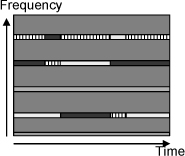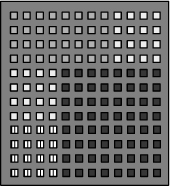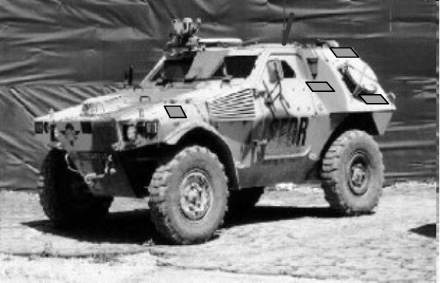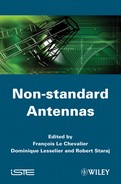Chapter 4
Multifunction Antenna System Concepts:
Opportunity for Ultra-wideband Radars?1
4.1. Multifunction radio frequency (RF) systems
4.1.1. Multimission platforms and multifunction RF systems
The increased needs for surveillance, communication, localization and navigation on future military platforms, either for airborne applications or for naval and land operations, leads to an increasingly difficult integration of all these functionalities. It is especially true if the various systems are just installed separately side by side as is the case today. Of course, the various military platforms have very different operational concepts of use, and their frequency bands may be different depending on the applications (airborne, naval or land). When several RF functions are used on the same platform, every new RF system to be installed results in a real implementation nightmare with problems concerning electromagnetic compatibility, stealth, weight, volume, aerodynamic drag, structural resistance and certification issues (for example it must be proven that the new installed system does not degrade navigability for airborne platforms).
There is consequently a crucial challenge of reducing the number of antennas and RF units. This leads to development of the concept and analysis of the possible performances of multifunction RF systems, which are able at least to share the radiating elements, and for a more ambitious solution which would share most of the RF chains including transmission and receiving front-ends realized with solidstate modules.
A multifunction RF system would also allow an intrinsic evolution capacity and would facilitate the implementation of new functionalities without modifying the characteristics of the platform (structure, EMC and stealth).
Research and development (R&D) studies have already been conducted with tight collaborative activity between platform and equipment manufacturers in order to use the same antenna for several RF functions. However, here, in the so-called SIMEF project, the objective was to entirely re-examine the concepts of multifunction RF systems, taking into account the most advanced technologies, in order to define several promising solutions for airborne, naval and land multifunction RF systems.
From a general point of view, multifunction RF systems for a military platform have to implement, at least partly:
– radar functions;
– electronic warfare functions (ESM and ECM);
– communications and radio navigation functions.
4.1.2. Analysis of operational use and possible sharing alternatives
The development and use of a multifunction RF system immediately raises questions about the operational use of the various RF functionalities. According to the mission of the day, according to the operational situation at a given moment, the RF functionalities to use and the way to use them are different. So the requirements in terms of simultaneous or successive use, exclusive use, or forbidden use of a function when another function is activated have to be investigated.
Performance requirements for the various functions have likewise to be analyzed since the RF characteristics are not similar, in terms of angular coverage, frequency range, bandwidth, emitted power, angular resolution, sensitivity, and so on.
So in these conditions, the operational use of multifunction RF systems requires us to be able to reconfigure their characteristics depending on the functions they will activate at a given time. The baseline in terms of RF hardware relies on a wideband RF front-end able to fill the needs of various functions. This wideband chain must then be dynamically reconfigurable depending on the operational scenario.
The multifunction RF system will have to share its resources between different functionalities and allocate them separately to each elementary function according to the different phases of the mission.
Sharing of resources can be envisioned in three different domains:
– Frequency domain: it is possible to subdivide the total bandwidth of the RF multifunction system into different sub-bands used by each elementary function.
– Time domain: it is possible to separate in time the use of RF chains in order to allocate successive time slots to each elementary function.
– Space domain: the idea consists in sharing the antenna surface and allocating one specific part of the antenna to each elementary function
The alternative of bistatic architectures may also be studied.
Of course, these various sharing solutions raise questions for the designer of the multifunction RF system, concerning operational use, RF functionalities, and technological requirements (filter, dynamic distribution and recombination, etc.)
Figure 4.1. Frequency band and time sharing

Figure 4.2. Space sharing

4.1.3. Analysis of several multifunction RF systems in the framework of the SIMEF project
In the framework of the SIMEF project, first a review of RF functionalities required for different types of Airborne, Naval and Land platforms has been performed. Then the identification of several possible concepts of association of RF functions leads to numerous multifunction RF systems that can be envisioned, such as:
– “6–18 GHz” airborne multifunction RF system for combat aircraft with radar (air/air, air/ground), electronic warfare (EW) and communications;
– “6–18 GHz” naval multifunction RF system with radar, EW and communications (satellite links, radiolinks between ships, UAV datalinks);
– “widened S-band” naval multifunction RF system with radar and EW;
– “UHF & S-band” land multifunction RF system installed on a small terrestrial vehicle with radar, EW and communications;
– “0.1 – 1 GHz passive” land multifunction RF system for terrestrial vehicles;
– “Low frequency” airborne multifunction RF system for large aircraft with SAR FOPEN radar, EW and communication functions;
– “Ku-Ka” airborne multifunction RF system for UAV with ground imagery and target detection radar (SAR GMTI) and communications (data relay).
4.1.4. Technological requirements for multifunction RF systems
The advanced technologies required for the multifunction RF systems identified above have been analyzed, and the possible architectures as well. Then the main technological advances that are needed for allowing the development of multifunction RF systems, their implementation and integration of future military platforms have been identified. Two types of technology can be distinguished here, those that will be improved anyway without the development of multifunction RF systems, and those that are really specific to the multifunction case (wideband, bipolarization, reconfigurable, more advanced circuit integration).
As far as specific technologies for multifunction RF systems are concerned, the evolutions that are the most expected have to do with:
– wideband radiating elements and antenna arrays, with compact and thin configuration, necessarily with electronic scanning possibility, double polarization and/or polarization agility;
– wideband radome, especially for the forward looking radar of combat aircraft;
– Tx-Rx wideband active modules (with their various units: HPA, LNA, limiter, phase shifter, switches, etc.). These modules must keep the same performances on the whole band in terms of transmitted power and efficiency, noise factor and resistance to high power sources on the receiving side. HPA must accommodate saturated and linear modes for radar and communications modes;
– agile, tunable or switchable, compact filters;
– technology linked to distribution and recombination of RF signals, with a possibility of dynamic reconfiguration (either optical, optoelectronic or microwave solutions);
– digital technology (ADC, DAC, DPS, etc.) with wideband, high dynamic and high sampling frequency characteristics
– high density integration technology for microwave integrated circuits: thermal management, high density 3D packaging (multilayer integrated circuits), connections;
– dynamic management of DC supplies.
An important point concerns the software management of the multifunction system, which needs to become an intelligent part, able to react to different situations during the mission and able to efficiently use the available resources (hardware, time, space, frequency band) for all the RF functions.
4.2. Multifunction RF systems and Ultra-Wideband (UWB) radars
4.2.1. Characteristics of UWB RF front-end
UWB radars are based on the use of very large bandwidths. Depending on the authors, different definitions may be found for UWB radar waveforms, from a relative bandwidth of at least 30% up to a ratio of maximal to minimal frequency of several units.
The temporal characteristics of UWB radar are also of various types, with very short pulses radar or rapid frequency agile wideband radar.
The critical characteristics of RF front-ends for UWB radars include:
– The frequency domain, where good performances on a wideband are needed for circuit matching, antenna directivity and gain, polarization purity and phase centre location.
– The temporal domain which is specific to UWB radars, and especially:
– low dispersion,
– high phase stability,
– low distortion for radar pulses, because it impacts radar efficiency and generation of ghost target.
For the antenna of the UWB radar, the design has to take into account and manage possible resonance modes which can result in oscillating impulse response and then generate ghost targets or unwanted transient radiation behavior.
Antenna arrays are usually necessary for providing sufficient directivity and electronically scanning capacity to the UWB radar. In these conditions, critical aspects for UWB arrays are mostly:
– transient response of the radiating element;
– additional effects due to the array, for example resonance (“ringing effects”) due to feeding distortions and mutual coupling between radiating elements;
– beamforming network with no dispersive effects.
4.2.2. Reuse of a multifunction RF system for a UWB radar function
According to the above characteristics for multifunction RF systems, the use of the RF front-end for UWB radars can be directly deduced since all wideband characteristics of a multifunction RF system are useful for a UWB radar.
However, UWB radar application additionally requires analysis of the transient behavior of the multifunction RF system front-end, and especially pulse distortion, phase distortion, and resonance effects.
The multifunction RF system also exhibits the capacity of generating reconfigurable waveforms and radiating patterns.
For UWB radars, the use of the multifunction RF system should allow:
– a dynamic adaptation of wideband waveforms according to the environment;
– a capacity of advanced evolution in terms of UWB waveforms;
– the crossed correlation of information coming from other functions (the SIGINT function for example) in order to obtain a better localization and reconnaissance of the target and to use the UWB radar only if mandatory.
4.2.3. Example of UWB radar function added to a multifunction RF system
In order to show how an UWB radar function may benefit from the development of a multifunction RF system, we have studied a perfectly arbitrary example. The reference multifunction RF system could be installed on a terrestrial vehicle aimed at tactical reconnaissance missions, as illustrated in Figure 4.3. It could then be associated with:
– a COMINT system with 100 MHz to 1 GHz receivers covering 360° in azimuth with several antennas;
– a software radio communication system covering a frequency between 30 and 512 MHz, with a transmitted power of 10 W CW.
We could then think of associating an UWB radar function allowing the detection of hidden objects or people in urban environments or in forested areas, by benefiting from the already installed equipment.
Figure 4.3. Possible integration of multifunction antennas on a reconnaissance vehicle

For radar function, the targeted characteristics would be as follows:
– detection range 300 m, with 0.2 ms pulse duration and 2 ms repetition period;
– UWB waveform for clutter rejection, with 100 MHz coherent bandwidth for 150 cm resolution;
– long integration time (> 250 ms), in order to improve S/N and S/C ratios (in the case of a fixed platform and slowly moving target).
The radar sensor would only require specific signal processing (possibly with a dedicated processor) on top of the existing RF equipment, and would be based on:
– UWB signal generation with the software radio transmitter;
– reception though one of the COMINT antenna for Doppler-distance detection of potential targets in the angular sector covered by the antenna;
– angular localization of the detected target, which would be improved by interferometric processing on two or several COMINT antennas, with an accuracy of around 10 m to 300 m.
The terrestrial platform would therefore benefit from an important advantage at a reduced cost thanks to improved performances. The platform would benefit from data fusion from other RF functions and from complementary use of the UWB radar and other functions.
Of course, frequency allocation issues have to be taken into account for transmitted UWB radar signals, but these could be facilitated by association with wideband ESM.
4.3. Conclusion
Future military platforms will have an increasing need for RF sensors and communication links, which require the development of multifunction RF systems in order to decrease the number of boarded antennas and optimize the use of RF front-ends. These multifunction RF systems will mandatorily be wideband and highly reconfigurable; they could also be multistatic.
For some applications and for some types of military platforms, these characteristics can offer the opportunity to introduce an UWB radar functionality which would use the same antenna system, and would necessitate only a dedicated signal processor.
4.4. Bibliography
[BAR 08] BAROUX M.H., LE MOINE C., DELHOTE C., CHRISTOPHE F., “Multifunction RF front-ends: an opportunity for UWB radars?”, Specialist’s Meeting on Ultra Wideband Radar Systems (Proc.: RTO-MP-SET-120), Toulouse, 27–28 October 2008.
[HUI 05] HUIZING A.G., “Wideband vs. multiband trade-offs for a scalable multifunction RF system”, Proc. IEEE Radar Conference, Airlington, Virginia, USA, 9–12 May 2005.
[TAV 05] TAVIK G.C. et al., “The advanced multifunction RF concept“, IEEE Transactions on Microwave Theory and Techniques, vol. 53, no. 3, March 2005.
1 Chapter written by Joël LEMORTON, Christophe LE MOINE, Christian DELHOTE, Florent CHRISTOPHE.
